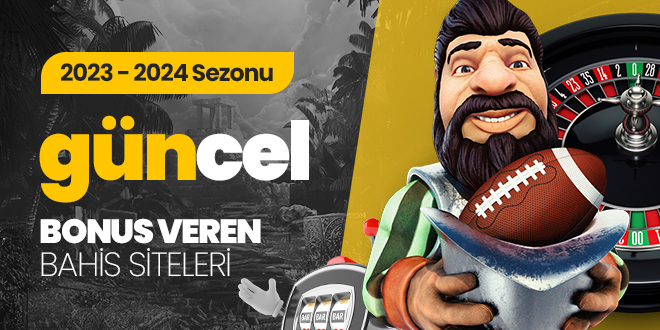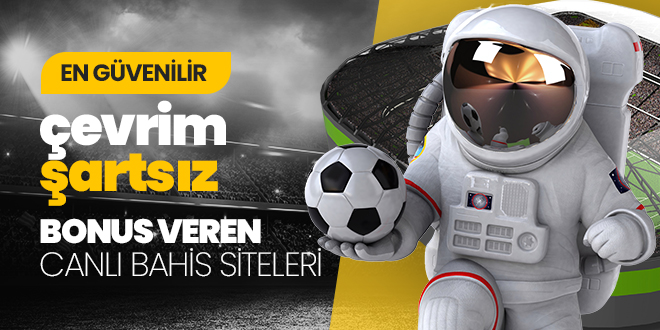Günümüzde çevrimiçi bahis sitelerinin popülerliği artarken, kullanıcılar arasında da yoğun bir rekabet yaşanmaktadır. Bu rekabet ortamında bahis siteleri, yeni kullanıcıları çekmek ve mevcut kullanıcılarını memnun etmek için çeşitli kampanyalar ve bonuslar sunmaktadır. Ne var ki deneme bonusu da bu kampanyalardan biridir. Deneme bonusu veren siteler bahis ve casino tutkunları için oldukça cazip fırsatlar sunmaktadır. Ek olarak bahis siteleri ve casino siteleri tarafından pazarlama stratejisi olarak kullanılır. Yeni kullanıcıları siteye çekmek ve onları kalıcı müşterilere dönüştürmek amacıyla sunulurlar. Türkiye pazarında hizmet veren en popüler deneme bonusu veren siteler 2024 listesi şöyledir:
- Betturkey : 100TL Spor Bonusu
- Betmatik : 200TL Casino Bonusu
- Betwoon : 80TL Casino Bonusu
- Ultrabet : 150TL Freespin
- Tarafbet : 100TL Freebet
- Restbet : 200TL Deneme Bonusu
- Onwin : 111TL Casino Bonusu
- Arzbahis : 50TL Spor Bonusu
Bu siteler, yüksek oranlar ve geniş oyun seçenekleri sunarak kullanıcıların ilgisini çekmektedir. Deneme bonusu sayesinde kullanıcılar, riske girmeden siteyi test edip ve kazanç elde etme şansına sahiptirler. Ancak, her sitenin belirli kuralları ve şartları vardır. Bu yüzden kullanıcılar bonusları almadan önce bu kuralları dikkatlice okumalıdır.
Bonus Veren Siteler
Deneme bonusu, online bahis ve casino sitelerinde yeni üyelere sunulan bir tür promosyondur. Bu promosyonu sunan sitelere de bonus veren siteler denir. Bonus, kullanıcıların siteyi denemeleri ve oyunlara katılmaları için bir fırsat olarak sunulur. Deneme bonusu, kullanıcılara para yatırmadan belirli bir miktar ücretsiz bahis veya casino oyunu oynama imkanı sağlar.
Bonus veren siteler, genellikle yeni üyeleri çekmek ve onlara deneme fırsatı sunmak amacıyla bu tür promosyonlar verir. Bu bonuslar, siteye üye olan kullanıcılara sunulan ilk fırsatlardan biridir. Genellikle belirli bir süre içinde kullanmak gerekmektedir. Kullanıcılar, deneme bonusunu kullanarak siteyi ve oyunları test eder ve daha sonra gerçek para ile bahis yapmaya karar verir.
Bahis ve casino oyunlarında bonus veren siteler, kullanıcılar için çekici bir seçenek olabilir. Bonuslar, oyunculara ekstra avantajlar sağlar ve daha fazla kazanma şansı sunar. Bonus veren siteler bahis severlere her açıdan güncel bonus ve cazip promosyon teklifleri sunar. Çünkü bonus demek bedava bahis oynamak ya da yatırımlara ek verilen kampanya tutarları ile daha fazla bahis oynamak anlamına gelir. Bu nedenle bonus kullanmak için site tercihi yaparken yabancı bahis sitelerinin lisans sertifikalarının olup olmadığına dikkat edilmelidir.
Deneme Bonusu
Deneme bonusu ile birçok farklı oyunu oynayabilirsiniz. Bu bonus genellikle spor bahisleri, casino oyunları, slot makineleri ve poker gibi oyunlarda geçerlidir. Her site farklı bir deneme bonusu programına sahip olabilir. Bu yüzden bonusun hangi oyunlarda oynandığını öğrenmek için site kurallarını kontrol etmeniz önemlidir.
Deneme bonusu veren siteler arasında bazı farklar vardır. Örneğin, bazı siteler daha yüksek miktarda deneme bonusu sunarken, bazıları daha az miktarlarda bonus verir. Ayrıca, her sitede farklı koşullar ve şartlar mevcuttur. Bu nedenle, deneme bonusunu kullanmadan önce her zaman site kurallarını okumanız önemlidir. Güvenilir deneme bonusu 2024 listesi aşağıdaki gibidir ;
- Bahiscom (333 TL + 333 Freespin)
- Tarafbet (250 TL + 175 Freespin)
- Restbet (100 TL + 100 Freespin)
- Sahabet (250 TL + 250 Freespin)
- Tipobet (200 TL + 100 Freespin)
- Onwin (200 TL + 200 Freespin)
- Grandpashabet (250 TL + 250 Freespin)

Deneme Bonusu Veren Bahis Siteleri
Deneme bonusu veren bahis siteleri, bahis severler için oldukça cazip fırsatlar sunan platformlardır. Bu sayede kullanıcılar, siteyi deneyerek oyunlar oynayabilir ve kazanç elde etme şansı yakalayabilirler. Deneme bonusu, kullanıcılara siteyi tanıma ve deneme fırsatı sunarken, aynı zamanda sitenin oyun seçeneklerini de keşfetmelerine olanak sağlamaktadır.
Deneme bonusu veren bahis siteleri, avantajlarıyla da dikkat çekmektedir. Bu sitelerde deneme bonusu ile oyunlara başlamak için herhangi bir para yatırma işlemi yapmanız gerekmez. Sadece üyelik oluşturmanız yeterlidir. Ayrıca deneme bonusuyla kazandığınız miktarı da gerçek para olarak çekebilme imkanınız bulunmaktadır. Bu da kullanıcıların hiç risk almadan ve ücretsiz şekilde bahis oyunlarını deneyimlemelerini sağlar.
Deneme bonusu veren bahis sitelerinde birçok oyun seçeneği bulunmaktadır. Spor bahisleri, casino oyunları, slot makineleri, poker ve daha pek çok seçenek deneme bonusuyla oynanabilir. Bu sayede kullanıcılar, kendilerine en uygun olan oyunları deneyerek eğlenceli vakit geçirebilirler. Bonusla oynanabilen oyunlar, bahis severlerin ilgi alanlarına göre geniş bir yelpazede sunulmaktadır.

Bonus veren siteler genellikle farklı miktarlarda ve farklı koşullarla bonuslar sunar. Bazı siteler, üyelerine yatırım yapmadan bonus verirken, bazıları belirli bir miktar yatırım yapılmasını şart koşar. Bu nedenle, kullanıcılar bonus veren siteler 2024 listesinden site seçerken dikkatli olmalı ve bonusların şartlarını dikkatlice okumalıdır.
Bedava Bonus
Bedava bonus, online bahis siteleri tarafından sunulan promosyonlardır. Bu bonuslar, yeni üyelerin siteyi, denemeye teşvik etmek ve onlara deneme fırsatı sunmak amacı taşır. Genellikle para yatırma veya bahis yapma şartı yoktur. Ek olarak kullanıcıların belirli oyunları deneyerek kazanç elde etme şansına olanak sağlar.
Bedava bonuslar, bahis severler için birçok avantaj sunmaktadır. İlk olarak, kullanıcılar oyunları risk almadan deneyebilirler. Bu bonuslar, oyunculara gerçek para ile oynamadan strateji geliştirme ve oyunları anlama fırsatı verir. Ayrıca, bedava bonus sayesinde yeni bahis sitelerini ve oyunları keşfetme fırsatı elde edebilirsiniz. Bu bonuslar, kullanıcıların potansiyel olarak kazançlı ve güvenilir bir site seçmelerine yardımcı olur.
Bonusla birçok oyunu oynayabilirsiniz. İlk olarak bedava bonus genellikle slot oyunlarında geçerlidir. Slot oyunları, bahis sitelerinde en popüler oyunlardan biridir ve farklı temalara, özelliklere ve kazanç potansiyellerine sahiptir. Ayrıca, canlı casino oyunları da oynayabilirsiniz. Canlı casino oyunları, gerçek krupiyelerle oynanan interaktif oyunlardır ve gerçek bir kumarhane deneyimi sunar. Poker, blackjack, rulet gibi klasik casino oyunları da bedava bonus veren sitelerde mevcuttur.
Yatırım Şartsız Deneme Bonusu Veren Siteler 2024
Yatırım şartsız deneme bonusu veren siteler, online bahis dünyasında son zamanlarda oldukça popüler hale gelmiştir. Çünkü bu bonus türü, bahisçilere hesaplarına para yatırmadan kullanabilecekleri bir miktar bonus sağlar. Peki, yatırım şartsız deneme bonusu nedir ve bu sitelerin 2024 yılında avantajları nelerdir?
Kullanıcıların hesaplarına para yatırmadan elde edebilecekleri bonus türü yatırım şartsız deneme bonusudur. Bu bonusu elde etmek için genellikle hesap oluşturmanız yeterlidir. Bu siteler, kullanıcıların platformlarını denemeleri ve oyunları riske atmadan tecrübe kazanmaları için bu bonusu sunarlar.
2024 yılı itibari ile yatırımsız deneme bonusu avantajlı bir bonus türüdür. İlk olarak, bu bonus türü kullanıcıların riske atmadan oyunları denemelerine ve stratejilerini geliştirmelerine olanak sağlar. Aynı zamanda, kullanıcıların sitenin sunduğu oyun çeşitliliğini keşfetmelerine ve farklı oyunlara yönelmelerine olanak tanır.
| Site Adı | Deneme Bonusu Miktarı |
|---|---|
| Sportotobet | 50 TL |
| Royalbet | 100 TL |
| Mariobet | 200 TL |
| Tipobet | 150 TL |
| Matadorbet | 200 TL |
Bahis Siteleri
Bahis siteleri, online olarak spor bahisleri ve casino oyunları gibi şans oyunlarını oynayabileceğiniz platformlardır. Bu sitelerde kullanıcılar, farklı spor dallarına veya casino oyunlarına bahis yaparak kazanma fırsatı elde eder. Bahis siteleri, teknolojinin hızla gelişmesiyle birlikte popülerlik kazanmıştır ve her geçen gün daha da fazla kişiye ulaşmaktadır.
Genellikle deneme bonusu gibi avantajlar sunan bahis siteleri, kullanıcıların siteyi denemelerini ve oyunlara katılmalarını teşvik etmektedir. Deneme bonusu, bahis sitelerinde yeni üye olan kişilere sunulan bir promosyon hizmetidir. Bu bonuslar sayesinde kullanıcılar, siteye para yatırmadan önce belirli bir miktar ücretsiz bahis veya casino oyunları oynama şansı elde ederler.
| Bahis Siteleri | Avantajları |
|---|---|
| 1. Superbetin | Canlı bahis seçeneği, yüksek oranlar |
| 2. Padişahbet | Geniş spor ve oyun seçeneği, hızlı ödeme |
| 3. Gobahis | Deneme bonusu, mobil uyumlu site |
Kullanıcılara sunulan avantajların bir başka çeşidi ise çeşitli bonuslar ve promosyonlardır. Deneme bonusunun yanı sıra, yatırım bonusu, kayıp bonusu, arkadaşını getir bonusu gibi farklı bonus seçenekleri mevcuttur. Bu bonuslar, kullanıcıların daha fazla kazanç elde etmelerine yardımcı olur ve oyun deneyimini daha da heyecanlı hale getirir.
Bahis sitelerinde üyelik işlemleri oldukça basittir. Genellikle siteye üye olmak için bir kayıt formu doldurmanız ve belirli bilgileri sağlamanız gerekmektedir. Üyelik işleminden sonra, hesabınıza para yatırıp ve bahis yapmaya başlayabilirsiniz. Bahis siteleri, güvenli ödeme yöntemleri ve veri koruma sistemleri kullanarak kullanıcıların bilgilerini korumakta ve güvenli bir oyun ortamı sağlamaktadır.
Bahis Sitelerinde Üyelik İşlemleri
Günümüzde bahis siteleri, online bahis oyunlarını oynamak isteyenler için oldukça popülerdir. Ancak bahis sitelerinde oyunlara katılabilmek ve para kazanabilmek için öncelikle üyelik işlemlerinin tamamlanması gerekmektedir. Bu yazıda, bahis sitelerinde üyelik işlemleri hakkında detaylı bilgi bulabilirsiniz.
Bahis sitelerine üye olmak için öncelikle güvenilir bir bahis sitesi seçmelisiniz. Güvenilir bir bahis sitesi, kullanıcıların kişisel bilgilerini koruyan ve adil oyun politikalarına sahip olan bir platform olmalıdır. Üyelik işlemleri genellikle online olur ve bazı kişisel bilgilerin paylaşılması gerekir. Üyelik işlemlerine geçerken, deneme bonusu gibi avantajlardan faydalanma şansına sahipsiniz.
Bahis sitelerinde üyelik işlemlerinin tamamlanması genellikle basittir. İstenen bilgiler arasında ad, soyad, e-posta adresi, doğum tarihi gibi temel kişisel bilgiler yer alır. Ayrıca, kullanıcı adı ve şifre oluşturmanız da istenir.
Bazı bahis siteleri, üyelik işlemlerinin tamamlanmasının ardından kimlik doğrulama adımı da ister. Bu adımda, kullanıcıların kimlik belgelerini (kimlik kartı, pasaport, ehliyet) sunarak hesaplarını doğrulamaları gerekmektedir.
- Bahis sitelerinde üyelik işlemlerini tamamlamadan önce siteyi detaylı bir şekilde inceleyin.
- Güvenilir bir bahis sitesi seçerek kişisel bilgilerinizin güvende olduğundan emin olun.
- Üyelik işlemlerinde deneme bonusu gibi avantajlardan faydalanmayı unutmayın.
- Üyelik işlemlerinde talep edilen bilgileri doğru ve eksiksiz şekilde verin.
- Bazı sitelerde kimlik doğrulama adımı vardır, bu adımı tamamlamayı unutmayın.
Çevrimsiz Bonus Veren Siteler
Canlı bahis siteleri, son yıllarda online bahis oynayan kullanıcılar arasında büyük bir popülerlik kazanmıştır. Bu siteler, kullanıcılara gerçek zamanlı olarak spor etkinliklerine ve diğer bahis oyunlarına katılma imkanı sunmaktadır. Canlı bahis siteleri, kullanıcılarına heyecan dolu bir deneyim sunmanın yanı sıra birçok avantaj da sağlamaktadır. Bu avantajların başında da çevrimsiz bonus gelir. Oyuncuların yatırım yaptığı miktar kadar çevrimsiz bonus veren siteler her zaman bir adım öndedir. Bu sitelerde çeşitli bonus ve promosyon kampanyaları vardır. Bu sayede kullanıcılar siteyi dener ve oyunları riske atmadan kazanç elde etmesine olanak sağlar.

Geniş oyun seçenekleri tercih eden kullanıcılar için çevrimsiz bonus veren bahis siteleri en iyi seçeneklerden biridir. Bu sitelerde, futbol, basketbol, tenis gibi popüler spor etkinliklerine bahis yapabilirsiniz. Ayrıca casino oyunları, poker, rulet gibi şans oyunlarına da katılma imkanı bulunmaktadır. Canlı bahis siteleri, kullanıcılara birden fazla oyun seçeneği sunarak, herkesin zevkine uygun bir oyun bulabilmesini sağlamaktadır.
Çevrimsiz Deneme Bonusu 2024
Çevrimsiz deneme bonusu, bahis siteleri tarafından sunulan ve çevrim şartı olmayan bir tür promosyondur. Buna göre bu bonus türü, kullanıcıların bahis yapmadan siteyi denemesine olanak tanır. Peki, 2024 yılında çevrimsiz deneme bonusu nasıl alınır?
| 1. Adım | Bir bahis sitesine üye olun. |
| 2. Adım | Hesabınıza giriş yapın. |
| 3. Adım | Çevrimsiz deneme bonusunu talep edin. |
| 4. Adım | Bonusu kullanmaya başlayın. |
Bu bonus türleri genellikle hesabınıza tanımlandıktan sonra kullanılır. Bazı siteler ise bonusun kullanılabilmesi için belirli şartlar öne sürer. Bu nedenle bonusu almadan önce sitenin kurallarını okumayı unutmamalısınız. Tüm adımları doğru bir şekilde takip ederek çevrimsiz deneme bonusunu alabilir ve bahis yapmadan kazanç elde edebilirsiniz.
 Deneme Bonusu Veren Siteler 2024
Deneme Bonusu Veren Siteler 2024